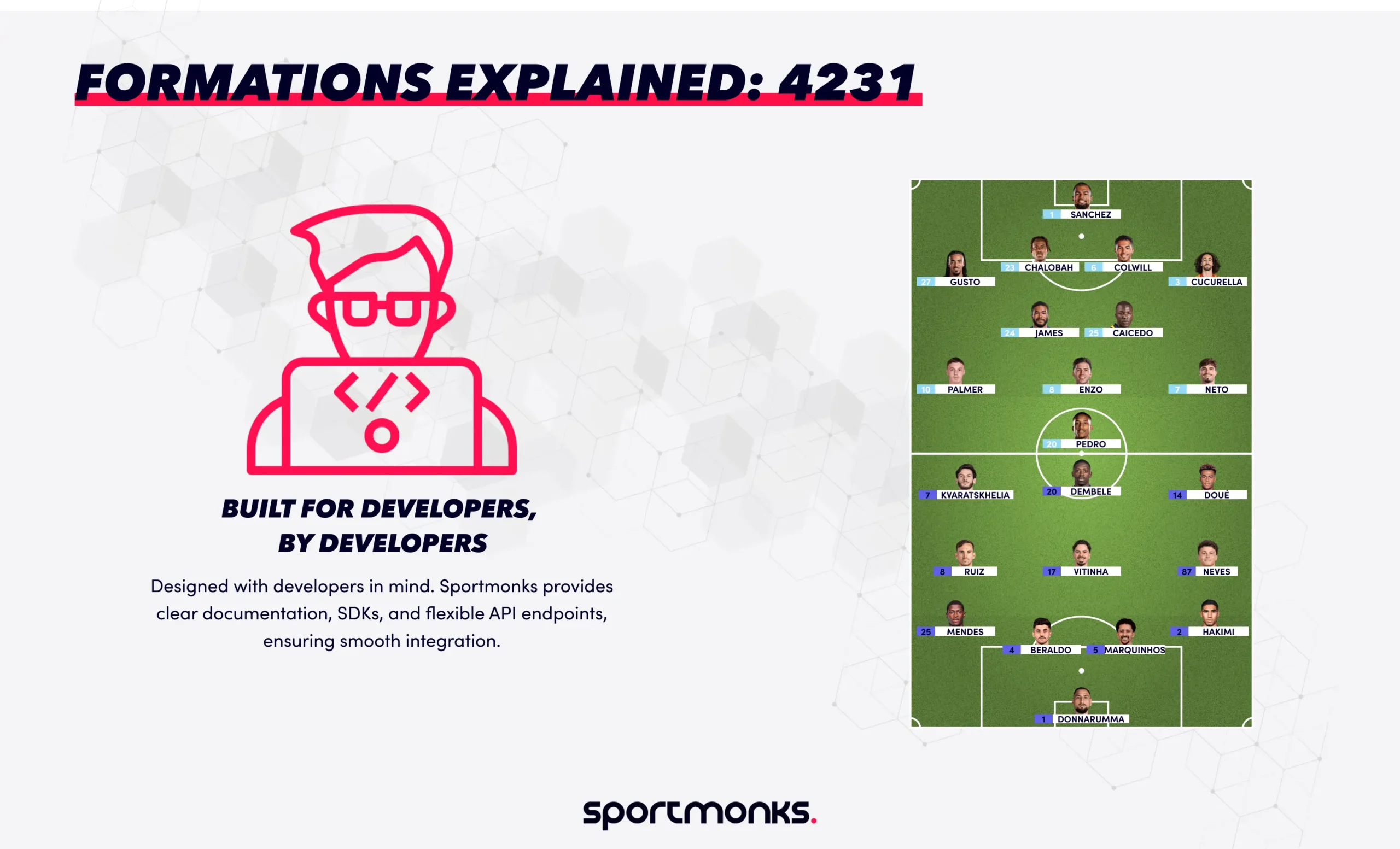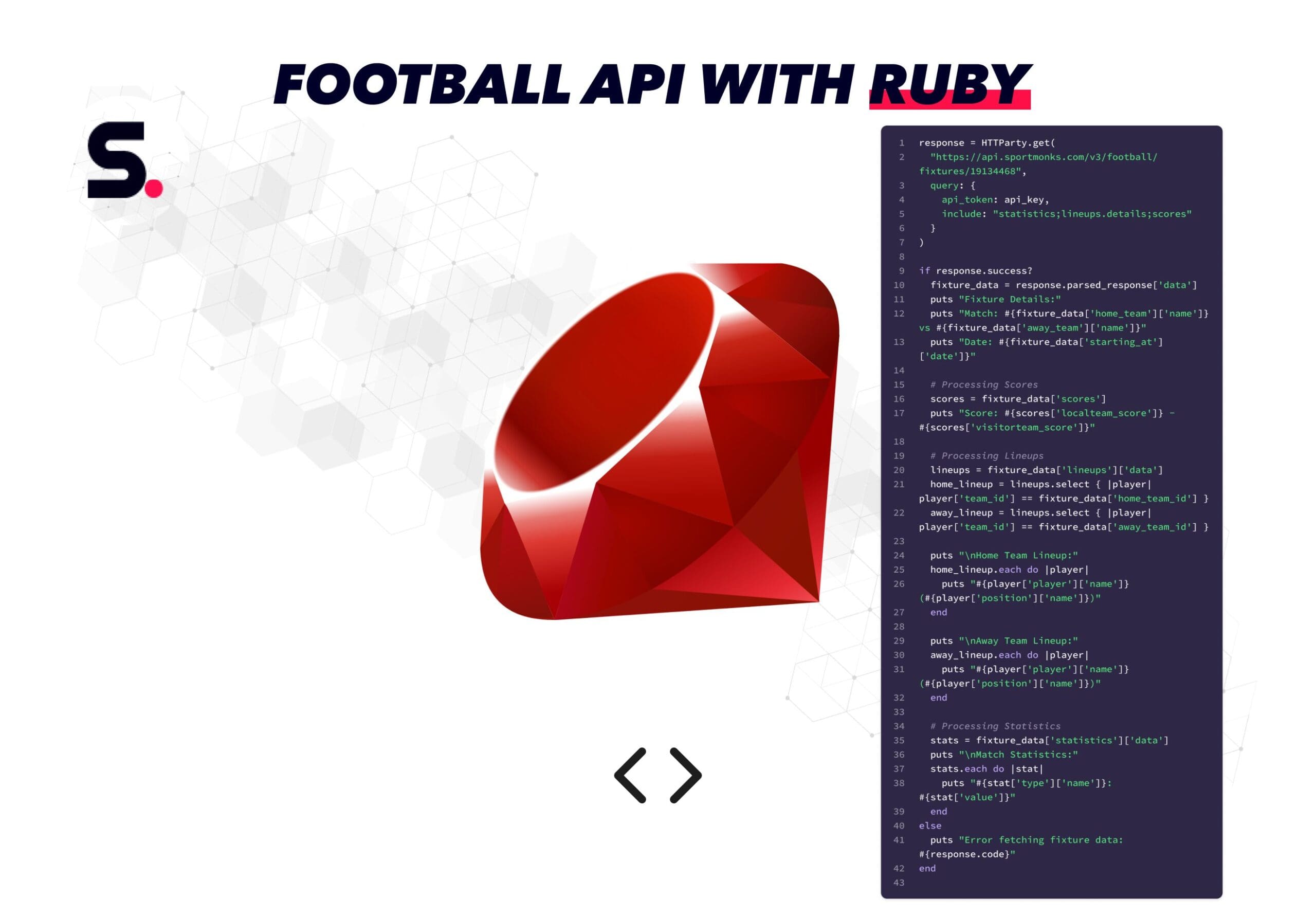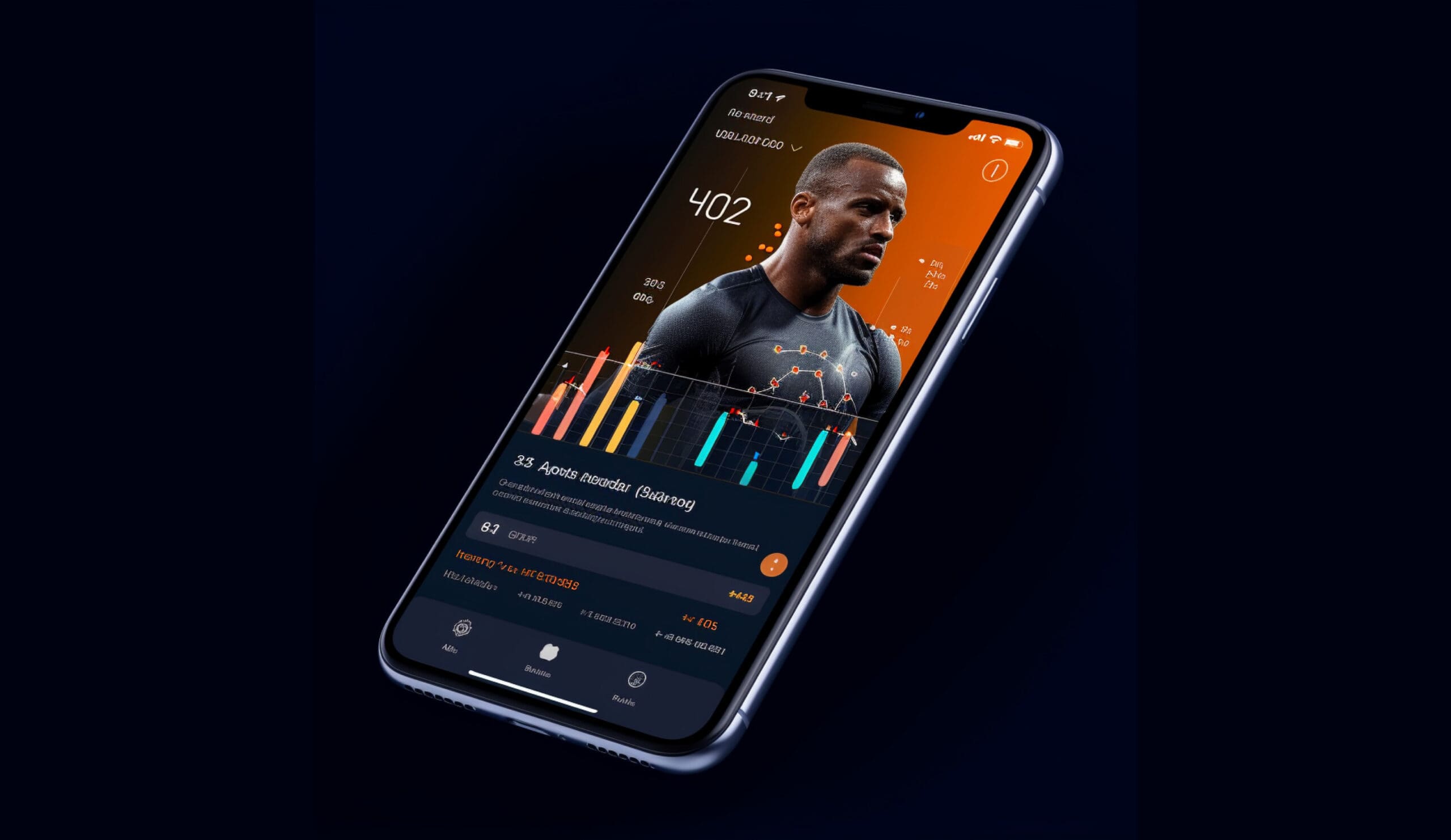
Contents
Formation structure & roles
The 4-2-3-1 formation is built with four key parts: a defensive line, two defensive midfielders, a trio of attacking midfielders, and a lone striker.
Defensive line (back four)
The foundation of the team is the back four, made up of two central defenders and two full-backs. The full-backs have a dual role: they support the defence on the wings but are also expected to push forward and overlap the wingers to provide crosses into the box.
Double pivot (two defensive midfielders)
Just in front of the back four are the two defensive midfielders, known as the double pivot. They act as a shield, breaking up the opposition’s attacks and helping to start attacks of their own. One of these midfielders usually focuses on winning the ball back and protecting the defence, while the other concentrates on distributing the ball and linking up play with the attacking players.
Attacking midfield trio
This group consists of a central attacking midfielder (the “number 10”), with two wide players (wingers or inside forwards) on either side. This trio is the creative heart of the team, responsible for making chances, running into dangerous areas, and scoring goals. The “number 10” operates in the space between the opposition’s defence and midfield, orchestrating attacks.
Lone striker
The lone striker leads the attacking line. They must be good at scoring goals, making smart runs to find space, and working with the three attacking midfielders behind them.
In-possession dynamics of the 4-2-3-1 formation
When a team using the 4-2-3-1 formation has the ball, their play is focused on maintaining a solid structure at the back while creating fluid, flexible attacks.
Build-up play and progression
– From the back with structure: The build-up often starts with the centre-backs and the goalkeeper. The two defensive midfielders (the double pivot) sit in front of the defence, with one sometimes dropping even deeper to create a numerical advantage. This makes it easier to pass the ball out safely and progressively into the midfield.
– Stretching and manipulating space: The full-backs push high up the pitch to provide width. With the double pivot controlling the centre, the team can draw opposition defenders out of position. This opens up passing lanes and creates space for the attacking midfielders to receive the ball.
Midfield creation and width
– Double pivot as a transition fulcrum: One of the two defensive midfielders typically stays deep to provide stability, while the other moves forward to support the attack. Their positioning is key to controlling the middle of the pitch, giving many passing options, and helping the team progress the ball into the final third.
– Attacking midfield trio’s fluidity: The central attacking midfielder (the number 10) looks to use the spaces between the opposition’s defensive and midfield lines to orchestrate play. The two wide players (wingers) can either stay wide to stretch the defence or move inside to create overloads and shooting chances.
Offensive combinations and triangles
– Built-in passing triangles: The formation naturally creates triangles involving the full-backs, the double pivot, and the wide attackers. These triangles are ideal for keeping possession, quickly shifting the focus of the attack, and breaking through the opposition’s lines.
– Positional rotation and overloads: The four attacking players, the three attacking midfielders and the striker can constantly swap positions. This pulls defenders out of their positions and creates confusion. In some systems, one of the defensive midfielders may also join the attack, or the formation may temporarily shift to a 4-3-3 to increase the attacking threat.
Out-of-possession responsibilities & pressing dynamics in the 4-2-3-1
When a team using the 4-2-3-1 formation does not have the ball, their main goal is to shift into a compact defensive shape. This allows them to stay organised and press the opposition effectively.
Shape transformation when defending
The 4-2-3-1 is designed to change into a tighter defensive formation, such as a 4-4-2 or 4-4-1-1, when they lose the ball. In these shapes, one of the wide attacking midfielders will tuck inside to add more players to the centre of the pitch, making it harder for the opposition to pass through. The striker and central attacking midfielder (CAM) form the first line of defence, working as a pair to press the opposition’s defenders.
Roles of the double pivot
The double pivot (the two defensive midfielders) plays a crucial role in defence. They sit just in front of the back four, providing a protective shield by covering the central areas and blocking passes. These midfielders must be good at winning the ball, keeping their defensive position, and knowing when to leave their zone to help a press or cover a full-back. They are also responsible for slowing down opposition counter-attacks and forcing the opposition to play out wide, away from the centre of the pitch.
Pressing triggers & compactness
High pressing with a 4-2-3-1 is a co-ordinated effort. The striker presses the opposition’s centre-backs, the wingers cover the spaces between the lines, and the CAM can either mark the opposition’s defensive midfielder or stay central. The double pivot then lines up against the opposition’s midfielders. This co-ordinated pressure reduces the opposition’s numerical advantage and makes it harder for them to build an attack, especially against formations like the 4-3-3.
Formations & tactical variations
Teams can change between a mid-block (defending from the middle of the pitch) and a low-block (defending deep in their own half) depending on the situation. In both cases, the attacking midfielders move closer together to clog the central passing channels and prevent the opposition from getting through. Teams can also use different pressing strategies, such as zonal (defending a specific area) versus man-marking (marking a specific player), and change their tactics based on how the opposition is playing.
Strengths and weaknesses of the 4-2-3-1 formation
The 4-2-3-1 formation is a popular choice for many managers due to its balance, but it also has its drawbacks.
Strengths
– Defensive stability & balance: The double pivot, consisting of two defensive midfielders, provides a strong shield in front of the back four. This makes it difficult for opponents to pass through the middle and helps the team transition from attack to defence smoothly.
– Midfield control & flexibility: With five midfielders, two defensive and three attacking, the formation allows a team to dominate the middle of the pitch. This gives them more passing options, more ways to outnumber the opposition in certain areas, and the ability to adapt as the game changes.
– Attacking versatility: The three attacking midfielders can create chances in many different ways. They can attack through the middle, overload the wings, or swap positions to confuse the opposition’s defence. This makes the attack unpredictable and dynamic.
– Tactical adaptability: A team can easily switch between a possession-based style and a counter-attacking style depending on who they are playing against and what the situation in the match is.
– Space utilisation & positional play: The system is great at creating outnumbering situations in the spaces between the lines. The full-backs push high to provide width, which creates a balanced and connected system for building attacks.
Weaknesses
– Lack of width in attack: With most of the players positioned centrally, it can be difficult to stretch a well-organised defence. The formation may not naturally provide enough width to break down a compact defensive block.
– Striker isolation risk: The lone striker can become isolated and struggle to get support if the attacking midfielders behind them are not getting forward enough. This is a particular problem against teams that use two physically strong central defenders.
– Heavy dependence on full-backs: The full-backs are crucial for providing width in attack. If they are not good at getting forward or are not available, it can unbalance the team both in attack and defence.
– Reliance on disciplined midfield anchors: The entire system relies on the double pivot to be disciplined. If these two midfielders make mistakes with their positioning, it can open up gaps in the defence, especially between the lines or during quick transitions.
– Vulnerable to overloads in midfield: Against formations with three central midfielders (like a 4-3-3), a team using a 4-2-3-1 can be outnumbered in midfield, which can make it hard for them to control possession and the tempo of the game.
– Communication & work-rate requirements: For the formation to work well, players must constantly communicate and have a high work-rate, especially the midfielders and wide players. If communication is poor, it can lead to uncoordinated pressing, slow transitions, or defensive mistakes.
Tactical variations & adaptations of the 4-2-3-1 formation
The 4-2-3-1 formation is highly adaptable, allowing managers to tweak it in many ways to suit different game situations.
Dynamic pressing configurations
– Pressing ten as a dual-role disruptor: The central attacking midfielder (the number 10) can either mark the opposition’s defensive midfielder or push forward to press the centre-backs. This creates a clever trap that can confuse the opposition.
– Striker or winger-led pressing shifts: In some systems, the lone striker might cover the opposition’s defensive midfielder, while the wingers and inside forwards press the opposition’s centre-backs. This changes how the team presses and gives the number 10 more freedom to drop deeper or rotate.
Transitioning into 4-4-2-style press
– Bayern Munich’s pressing tweak: For example, when pressing intensely, Bayern Munich’s central attacking midfielder, Thomas Müller, would often move up to join the striker, temporarily creating a 4-4-2 shape. The other midfielders would then adjust to mark the opposition’s players, which maintained defensive stability.
Strategic shaping to control opposition passes
– Forcing play wide or central: A team can intentionally position its players to block passes through the middle, forcing the opposition to play out wide. The wingers can then press wider to stop the opposition from switching the play, while the number 10 keeps a good position to intercept passes or delay the build-up.
Structural adjustments and positional fluidity
– Shifting into alternative formations mid-play: Players can change their positions during a match. For example, a full-back pushing higher up the pitch can create a defensive line of three. Meanwhile, the midfielders can rotate into positions that resemble a 4-3-3. These changes help a team adapt its defensive and attacking capabilities depending on the situation in the match.
– Bielsa’s offensive full-back variant: Marcelo Bielsa’s version of the 4-2-3-1 used attacking full-backs, centre-backs who were good on the ball, and midfielders who joined the attack. This was a system designed for teams with versatile and mobile players.
Why these variations matter
– Opponent-specific flexibility: These tactical shifts allow managers to change their tactics during a game to counter the opposition’s attacking threats or pressing systems.
– Equilibrium between structure and dynamism: By adjusting pressing patterns (e.g., focusing on central traps or putting pressure on the wings), a team can improve both its defensive solidity and its attacking unpredictability.
– Adaptability across match phases: These variations give a team a system that can smoothly transition between keeping possession, aggressive pressing, and disrupting the opposition’s passing lanes, all while maintaining a solid defensive structure.
Real-world teams & managers using the 4-2-3-1
Teams that have flourished with the formation
– Spain (2008–2012): The Spanish national team, during their period of global dominance, used a core 4-2-3-1 structure to win the European Championship in 2008 and 2012, as well as the 2010 World Cup. The formation gave them midfield control, a fluid attack, and defensive cover.
– Premier League prevalence: The 4-2-3-1 was the most used formation in the 2022/23 Premier League season, with 31 out of 39 managers using it at some point.
– Clubs: Elite teams such as Bayern Munich, Barcelona, Manchester United, and AC Milan have all used the 4-2-3-1, depending on the manager and the players they have. This shows how adaptable it is to different playing styles.
– Paris Saint-Germain (PSG) & Liverpool: PSG use this setup to accommodate their many star attackers, while Liverpool, under Jürgen Klopp, switched between the 4-2-3-1 and 4-3-3 depending on the demands of the match.
Managers championing the 4-2-3-1
– Pep Guardiola: A modern advocate of the formation, Guardiola has consistently shaped his teams around this system, using its balance for both structure and pressing.
– Erik ten Hag & Arne Slot: These are two contemporary managers known for using the 4-2-3-1 to maximise midfield control and attacking flexibility.
– José Mourinho: During his time at Real Madrid and Tottenham, Mourinho often favoured the 4-2-3-1, tailoring it into a solid counter-attacking formation.
– Ole Gunnar Solskjær: While being Manchester United’s manager, Solskjær often used the 4-2-3-1 to adapt to pressing and quick attacks.
– Enzo Maresca (Chelsea): At the start of his time as manager, Maresca changed Chelsea’s formation from a 4-3-3 to a 4-2-3-1, blending intense pressing with a structured build-up from defence.
– Frank Lampard (Coventry City): Lampard, who is known for his teams’ width and pressing, is expected to use the 4-2-3-1 in his push for promotion.
Sportmonks: A football data powerhouse
Sportmonks is a great football data provider, offering a wide range of high-quality data through a developer-friendly API. It’s especially useful for content that focuses on formations and line-ups because:
– Formation and line-up data: Our Football API has endpoints that let you directly get team formations (e.g., 4-2-3-1) and detailed player positions, including their specific roles like “centre-back” or “attacking midfield” and whether they are a starter or on the bench.
– Premium expected line-ups: A key feature for pre-match planning, Sportmonks provides predictive line-ups based on player availability, team tactics, news, and recent performance. These forecasts give you early insight into likely formations and who will start. The system is also transparent, allowing users to see which line-ups are predictions and which are confirmed.
– Robust developer resources: Sportmonks provides clear documentation, tutorials, and guides. This includes step-by-step instructions on how to build match pages that display formations and line-ups, and how to map player positions onto a pitch.
Get all the lineup info at your fingertips with Sportmonks
Our Football API provides full formation and line-up data, so you can easily identify whether a team sets up in a 4-2-3-1 or switches shape mid-game. With detailed player positions, roles, and live match events, you can go beyond surface-level stats to truly understand tactical dynamics.
Our Premium expected line-ups give you an edge before kick-off, predicting team selections based on availability, injuries, and tactical patterns. Combined with clear developer resources and easy-to-use endpoints, you can quickly integrate these insights into fantasy platforms, betting tools, or tactical dashboards.
Start building with Sportmonks today and bring tactical analysis like the 4-2-3-1 to life in your app or website.



